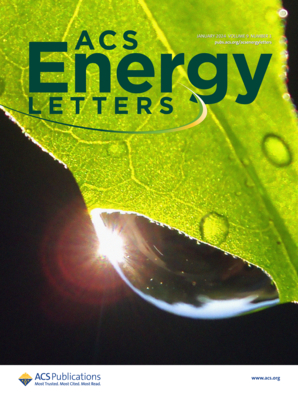Tailoring Thick Film Crystallization and Facet Orientation via Potassium Acetate for Efficient Bifacial Perovskite Solar Cells
IF 18.2
1区 材料科学
Q1 CHEMISTRY, PHYSICAL
引用次数: 0
Abstract
Bifacial perovskite solar cells (PSCs) require micron-thick perovskite layers to compensate for optical loss from transparent electrodes, but high defect densities limit efficiency. Here, we introduce a potassium acetate (KAc) post-treatment on microthick PbI2 films to form an amorphous KAc-PbI2 intermediate, which facilitates ammonium salt incorporation and promotes perovskite crystallization. During the second step, released Ac– and K+ ions selectively adsorb onto (111) and (001) facets, respectively, directing vertical crystal growth with (001) orientation. This strategy reduces defect density and improves film quality in thick perovskite layers. As a result, the bifacial PSC achieves a power conversion efficiency (PCE) of 21.33%, bifaciality exceeding 80%, and a record power generation density (PGD) of 24.72 mW cm–2 under 0.2 albedo, representing the highest reported PGD for n-i-p bifacial PSCs. After 500 h of continuous illumination at the maximum power point, the KAc-treated bifacial device retained its initial PCE.利用醋酸钾对双层钙钛矿太阳能电池的厚膜结晶和面取向进行裁剪
双面钙钛矿太阳能电池(PSCs)需要微米厚的钙钛矿层来补偿透明电极的光学损耗,但高缺陷密度限制了效率。在这里,我们引入了醋酸钾(KAc)后处理微厚PbI2薄膜,形成无定形的KAc-PbI2中间体,有利于铵盐的掺入,促进钙钛矿的结晶。在第二步中,释放的Ac -离子和K+离子分别选择性地吸附在(111)和(001)上,引导晶体沿(001)取向垂直生长。这种策略降低了缺陷密度,提高了厚钙钛矿层的薄膜质量。结果表明,双面聚苯乙烯材料的功率转换效率(PCE)达到21.33%,双面性超过80%,在0.2反照率下的发电密度(PGD)达到24.72 mW cm-2,是目前报道的最高的n-i-p双面聚苯乙烯材料的PGD。在最大功率点连续照明500小时后,经kac处理的双面器件保持其初始PCE。
本文章由计算机程序翻译,如有差异,请以英文原文为准。
求助全文
约1分钟内获得全文
求助全文
来源期刊

ACS Energy Letters
Energy-Renewable Energy, Sustainability and the Environment
CiteScore
31.20
自引率
5.00%
发文量
469
审稿时长
1 months
期刊介绍:
ACS Energy Letters is a monthly journal that publishes papers reporting new scientific advances in energy research. The journal focuses on topics that are of interest to scientists working in the fundamental and applied sciences. Rapid publication is a central criterion for acceptance, and the journal is known for its quick publication times, with an average of 4-6 weeks from submission to web publication in As Soon As Publishable format.
ACS Energy Letters is ranked as the number one journal in the Web of Science Electrochemistry category. It also ranks within the top 10 journals for Physical Chemistry, Energy & Fuels, and Nanoscience & Nanotechnology.
The journal offers several types of articles, including Letters, Energy Express, Perspectives, Reviews, Editorials, Viewpoints and Energy Focus. Additionally, authors have the option to submit videos that summarize or support the information presented in a Perspective or Review article, which can be highlighted on the journal's website. ACS Energy Letters is abstracted and indexed in Chemical Abstracts Service/SciFinder, EBSCO-summon, PubMed, Web of Science, Scopus and Portico.
 求助内容:
求助内容: 应助结果提醒方式:
应助结果提醒方式:


